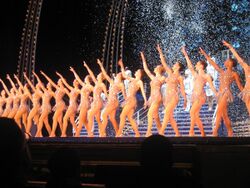Synchronization
 From HandWiki - Reading time: 7 min
From HandWiki - Reading time: 7 min
Synchronization is the coordination of events to operate a system in unison. For example, the conductor of an orchestra keeps the orchestra synchronized or in time. Systems that operate with all parts in synchrony are said to be synchronous or in sync—and those that are not are asynchronous.
Today, time synchronization can occur between systems around the world through satellite navigation signals and other time and frequency transfer techniques.
Time-keeping and synchronization of clocks is a critical problem in long-distance ocean navigation. Before radio navigation and satellite-based navigation, navigators required accurate time in conjunction with astronomical observations to determine how far east or west their vessel traveled. The invention of an accurate marine chronometer revolutionized marine navigation. By the end of the 19th century, important ports provided time signals in the form of a signal gun, flag, or dropping time ball so that mariners could check and correct their chronometers for error.
Synchronization was important in the operation of 19th-century railways, these being the first major means of transport fast enough for differences in local mean time between nearby towns to be noticeable. Each line handled the problem by synchronizing all its stations to headquarters as a standard railway time. In some territories, companies shared a single railroad track and needed to avoid collisions. The need for strict timekeeping led the companies to settle on one standard, and civil authorities eventually abandoned local mean time in favor of railway time.
Communication
In electrical engineering terms, for digital logic and data transfer, a synchronous circuit requires a clock signal. A clock signal simply signals the start or end of some time period, often measured in microseconds or nanoseconds, that has an arbitrary relationship to any other system of measurement of the passage of minutes, hours, and days.
In a different sense, electronic systems are sometimes synchronized to make events at points far apart appear simultaneous or near-simultaneous from a certain perspective.[lower-alpha 1] Timekeeping technologies such as the GPS satellites and Network Time Protocol (NTP) provide real-time access to a close approximation to the UTC timescale and are used for many terrestrial synchronization applications of this kind.
In computer science (especially parallel computing), synchronization is the coordination of simultaneous threads or processes to complete a task with correct runtime order and no unexpected race conditions; see synchronization (computer science) for details.
Synchronization is also an important concept in the following fields:
- Cryptography
- Lip sync
- Multimedia
- Rhythm
- Neuroscience
- Photography
- Physics (The idea of simultaneity has many difficulties, both in practice and theory.)
- Synthesizers
- Telecommunication
- Frame synchronization
- Synchronization (video)
Dynamical systems
File:Wesphysdemo - Synchronized Metronomes.webm
Synchronization of multiple interacting dynamical systems can occur when the systems are autonomous oscillators. Poincaré phase oscillators are model systems that can interact and partially synchronize within random or regular networks.[1] In the case of global synchronization of phase oscillators, an abrupt transition from unsynchronized to full synchronization takes place when the coupling strength exceeds a critical threshold. This is known as the Kuramoto model phase transition.[2] Synchronization is an emergent property that occurs in a broad range of dynamical systems, including neural signaling, the beating of the heart and the synchronization of fire-fly light waves.
Applications
Neuroscience
In cognitive neuroscience, (stimulus-dependent) (phase-)synchronous oscillations of neuron populations serve to solve the general "binding problem". According to the so-called "Binding-By-Synchrony (BBS) Hypothesis"[3][4][5][6][7][8][9] a precise temporal correlation between the impulses of neurons ("cross-correlation analysis"[10]) and thus a stimulus-dependent temporal synchronization of the coherent activity of subpopulations of neurons emerges. Moreover, this synchronization mechanism circumvents the "superposition problem"[11] by more effectively identifying the signature of synchronous neuronal signals as belonging together for subsequent (sub-)cortical information processing areas.
Cognitive science
In cognitive science, integrative (phase) synchronization mechanisms in cognitive neuroarchitectures of modern connectionism that include coupled oscillators (e.g."Oscillatory Networks"[12]) are used to solve the binding problem of cognitive neuroscience in perceptual cognition ("feature binding") and in language cognition ("variable binding").[13][14][15][16]
Human movement
Synchronization of movement is defined as similar movements between two or more people who are temporally aligned.[17] This is different from mimicry, which occurs after a short delay.[18] Line dance and military step are examples.
Muscular bonding is the idea that moving in time evokes particular emotions.[19] This sparked some of the first research into movement synchronization and its effects on human emotion. In groups, synchronization of movement has been shown to increase conformity,[20] cooperation and trust.[21][failed verification]
In dyads, groups of two people, synchronization has been demonstrated to increase affiliation,[22] self-esteem,[23] compassion and altruistic behaviour[24] and increase rapport.[25] During arguments, synchrony between the arguing pair has been noted to decrease; however, it is not clear whether this is due to the change in emotion or other factors.[26] There is evidence to show that movement synchronization requires other people to cause its beneficial effects, as the effect on affiliation does not occur when one of the dyad is synchronizing their movements to something outside the dyad.[22] This is known as interpersonal synchrony.
There has been dispute regarding the true effect of synchrony in these studies. Research in this area detailing the positive effects of synchrony, have attributed this to synchrony alone; however, many of the experiments incorporate a shared intention to achieve synchrony. Indeed, the Reinforcement of Cooperation Model suggests that perception of synchrony leads to reinforcement that cooperation is occurring, which leads to the pro-social effects of synchrony.[27] More research is required to separate the effect of intentionality from the beneficial effect of synchrony.[28]
Uses
Synchronization is important in digital telephony, video and digital audio where streams of sampled data are manipulated. Synchronization of image and sound was an important technical problem in sound film. More sophisticated film, video, and audio applications use time code to synchronize audio and video.[2] In movie and television production it is necessary to synchronize video frames from multiple cameras. In addition to enabling basic editing, synchronization can also be used for 3D reconstruction[29]
In electric power systems, alternator synchronization is required when multiple generators are connected to an electrical grid.
Arbiters are needed in digital electronic systems such as microprocessors to deal with asynchronous inputs. There are also electronic digital circuits called synchronizers that attempt to perform arbitration in one clock cycle. Synchronizers, unlike arbiters, are prone to failure. (See metastability in electronics).
Encryption systems usually require some synchronization mechanism to ensure that the receiving cipher is decoding the right bits at the right time.
Automotive transmissions contain synchronizers that bring the toothed rotating parts (gears and splined shaft) to the same rotational velocity before engaging the teeth.
Flash synchronization synchronizes the flash with the shutter.
Some systems may be only approximately synchronized, or plesiochronous. Some applications require that relative offsets between events be determined. For others, only the order of the event is important.[1]
See also
Notes
- ↑ Albert Einstein proved in 1905 in his first relativity paper that there actually are no such things as absolutely simultaneous events.
References
- ↑ 1.0 1.1 Nolte, David (2015). Introduction to Modern Dynamics: Chaos, Networks, Space and Time. Oxford University Press.
- ↑ 2.0 2.1 "The Surprising Secret of Synchronization". https://www.youtube.com/watch?v=t-_VPRCtiUg.
- ↑ Singer, W. (1999). Neuronal synchrony: A versatile code for the definition of relations. Neuron, 24, 49-65.
- ↑ Singer, W. (1999a). Binding by neural synchrony. In R. A. Wilson & F. C. Keil (eds.): The MIT encyclopedia of the cognitive sciences (pp. 81-84). Cambridge, MA, London: The MIT Press.
- ↑ Singer, W. (2009a). Consciousness and neuronal synchronization. In S. Laureys & G. Tononi: The neurology of consciousness: Cognitive neuroscience and neuropathology (pp. 43-52). Amsterdam: Elsevier.
- ↑ Singer, W. (2009b). Neural synchrony and feature binding. In L.R. Squire (Ed.) Encyclopedia of Neuroscience. Vol. 6 (pp. 253-259). Oxford: Academic Press.
- ↑ Singer, W. (2013a). The neuronal correlate of consciousness: Unity in time rather than space? Neurosciences and the Human Person: New Perspectives on Human Activities Pontifical Academy of Sciences. Scripta Varia. Vol. 121. Vatican City. 2013. From: www.casinapioiv.va/content/dam/accademia/pdf/sv121/sv121-singer.pdf
- ↑ Singer, W. (2013b). Cortical dynamics revisited. Trends in Cognitive Sciences 17, 616-626.
- ↑ Singer, W. (2018). Neuronal oscillations: unavoidable and useful? European Journal of Neuroscience 48, 2389-2399.
- ↑ Engel, A. K., König, P., Gray, C. M. & Singer, W. (1990). Stimulus-dependent neuronal oscillations in cat visual cortex: Intercolumnar interaction as determined by cross-correlation analysis. European Journal of Neuroscience, 2, 588-606.
- ↑ Malsburg, C. von der (1999). The what and why of binding: The modeler's perspective. Neuron, 24, 95-104.
- ↑ Werning, M. (2012). Non-symbolic compositional representation and its neuronal foundation: Towards an emulative semantics. In M. Werning, W. Hinzen & E. Machery (eds.), The Oxford handbook of compositionality (pp. 633-654). Oxford University Press. Oxford.
- ↑ Maurer, H. (2021). Cognitive science: Integrative synchronization mechanisms in cognitive neuroarchitectures of the modern connectionism. CRC Press, Boca Raton/FL, ISBN 978-1-351-04352-6. https://doi.org/10.1201/9781351043526
- ↑ Maurer, H. (2016). „Integrative synchronization mechanisms in connectionist cognitive Neuroarchitectures“. Computational Cognitive Science. 2: 3. https://doi.org/10.1186/s40469-016-0010-8
- ↑ Marcus, G.F. (2001). The algebraic mind. Integrating connectionism and cognitive science. Bradford Book, The MIT Press, Cambridge, ISBN 0-262-13379-2. https://doi.org/10.7551/mitpress/1187.001.0001
- ↑ Bechtel, W. & Abrahamsen, A.A. (2002). Connectionism and the Mind: Parallel Processing, Dynamics, and Evolution in Networks. 2nd Edition. Blackwell Publishers, Oxford.
- ↑ Condon, W. S.; Ogston, W. D. (1 October 1966). "Sound film analysis of normal and pathological behavior patterns". The Journal of Nervous and Mental Disease 143 (4): 338–347. doi:10.1097/00005053-196610000-00005. ISSN 0022-3018. PMID 5958766.
- ↑ Richardson, Michael J.; Marsh, Kerry L.; Schmidt, R. C. (1 February 2005). "Effects of visual and verbal interaction on unintentional interpersonal coordination". Journal of Experimental Psychology. Human Perception and Performance 31 (1): 62–79. doi:10.1037/0096-1523.31.1.62. ISSN 0096-1523. PMID 15709863.
- ↑ McNeill, William Hardy (30 September 1997). Keeping Together in Time. ISBN 978-0-674-50230-7. https://books.google.com/books?id=F5QqSt6umWsC.
- ↑ Dong, Ping; Dai, Xianchi; Wyer, Robert S. (1 January 2015). "Actors conform, observers react: the effects of behavioral synchrony on conformity". Journal of Personality and Social Psychology 108 (1): 60–75. doi:10.1037/pspi0000001. ISSN 1939-1315. PMID 25437130.
- ↑ "Synchrony and Cooperation – PubMed – Search Results". https://pubmed.ncbi.nlm.nih.gov/?term=Synchrony+and+Cooperation.
- ↑ 22.0 22.1 Hove, Michael J.; Risen, Jane L. (2009). "It's All in the Timing: Interpersonal Synchrony Increases Affiliation". Social Cognition 27 (6): 949. doi:10.1521/soco.2009.27.6.949.
- ↑ Lumsden, Joanne; Miles, Lynden K.; Macrae, C. Neil (1 January 2014). "Sync or sink? Interpersonal synchrony impacts self-esteem". Frontiers in Psychology 5: 1064. doi:10.3389/fpsyg.2014.01064. PMID 25285090.
- ↑ Valdesolo, Piercarlo; Desteno, David (1 April 2011). "Synchrony and the social tuning of compassion". Emotion 11 (2): 262–266. doi:10.1037/a0021302. ISSN 1931-1516. PMID 21500895.
- ↑ Vacharkulksemsuk, Tanya; Fredrickson, Barbara L. (1 January 2012). "Strangers in sync: Achieving embodied rapport through shared movements". Journal of Experimental Social Psychology 48 (1): 399–402. doi:10.1016/j.jesp.2011.07.015. ISSN 0022-1031. PMID 22389521.
- ↑ Paxton, Alexandra; Dale, Rick (1 January 2013). "Argument disrupts interpersonal synchrony". Quarterly Journal of Experimental Psychology 66 (11): 2092–2102. doi:10.1080/17470218.2013.853089. ISSN 1747-0226. PMID 24303888.
- ↑ Reddish, Paul; Fischer, Ronald; Bulbulia, Joseph (1 January 2013). "Let's dance together: synchrony, shared intentionality and cooperation". PLOS ONE 8 (8): e71182. doi:10.1371/journal.pone.0071182. ISSN 1932-6203. PMID 23951106. Bibcode: 2013PLoSO...871182R.
- ↑ Ellamil, Melissa; Berson, Josh; Margulies, Daniel S. (1 January 2016). "Influences on and Measures of Unintentional Group Synchrony". Frontiers in Psychology 7: 1744. doi:10.3389/fpsyg.2016.01744. PMID 27881968.
- ↑ Moore, Carl, et al. "Synchronization of images from multiple cameras to reconstruct a moving human." 2010 IEEE/ACM 14th International Symposium on Distributed Simulation and Real Time Applications. IEEE, 2010.
External links
 |
 KSF
KSF

